Creating and Using Variables
A variable is a named place where a value can be stored. Variables
can participate in comparisons and may be used in arithmetic or
string expressions. A Designer variable can be a special register,
a constant, or an XPath expression on the processed document.
Some variables are provided by the system. These variables, called
special registers, hold information that you might need in your
process flow. For example, the special register IP holds the source
IP address of a message that arrives through an IP protocol, such
as TCP or HTTP. You can refer to these built-in variables by the
special register function, SREG().
Run-time variables are evaluated and substituted each time the
process flow runs. A run-time variable can be one of two usage types;
‘header’, which indicates the variable is part of the document routing
information (such as, an HTTP header or an IBM MQSeries descriptor)
or ‘user’, which indicates all other variables.
Design-time variables are evaluated and substituted when the
process flow is compiled. Design-time variable names begin with
a dollar sign ($). Once in a run-time environment, these variables
do not change. For example, a design-time variable named $CompanyName
is assigned the value of ‘Acme’ and the process flow is compiled.
When you run this process flow, Acme will always be used as the
value for $CompanyName. To change this variable, you must change
the value in the design-time environment and recompile the process
flow.
The following procedure explains how to create a run-time variable
and also incorporates information on creating a design-time variable.
x
Procedure: How to Create a Run-Time Variable
To create
a run-time variable:
-
Access
the Property Manager in one of the following ways:
- From the Tools
menu, select Property Manager.
- From an existing
object in a process flow, right-click the object and select Properties.
From the object’s Properties dialog box, click the Properties tab
and select Create variable from a specific
property’s Value list.
- As you configure
an object being added to a process flow, select Create
variable from a specific property’s Value list.
The
Property Manager dialog box opens displaying the Design Time tab,
which exposes the design-time properties, as shown in the following
image.
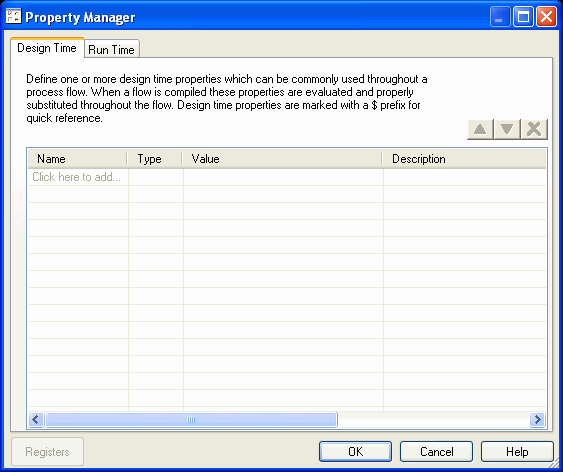
The design-time variable
properties are Name, Type, Value, and Description.
-
Select
the Run Time tab to access the run-time variable properties.
The following image shows the Run Time tab.
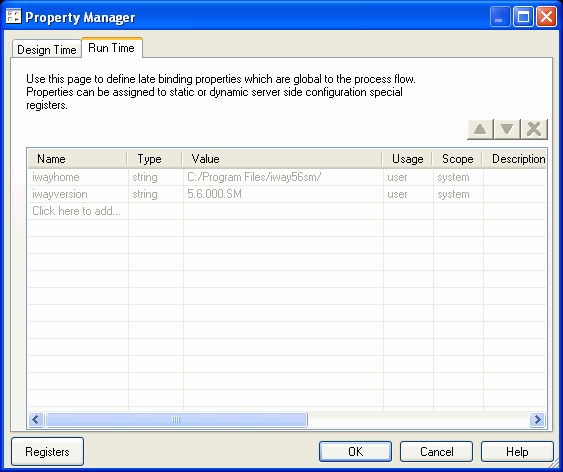
The run-time variable
properties are Name, Type, Value, Usage, Scope, and Description.
-
In the
Name column, click the field labeled Click here to Add.
The fields under each column of the Property Manager dialog
box are activated, as shown in the following image.
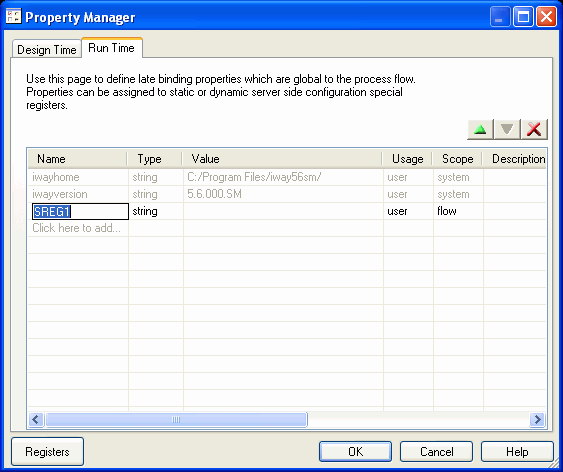
-
In the
Name field, type a descriptive name for the variable. The default name
is SREG1, SREG2, and so on.
-
In the
Type drop-down list, choose a variable type.
The variable type options are:
string. Text,
such as "The quick brown fox".
integer. A positive
or negative whole number, such as 12 or -3.
boolean. A
'0' (false) or a '1' (true).
decimal. A number in decimal
notation, such as 3.141.
duration. A time interval
in ISO standard form.
password. A string, the value
of which is hidden when entered.
Note: The default
usage in Designer is user.
-
In the
Value field, type a value or create an XPath expression for the variable.
Information on XPath expressions and how to create them appear later
in this section.
The following special registers are available in the Property
Manager:
[iwayversion], [iwayhome], [engine], [iwayconfig],
and [locale]
Note: To select a variable to work with
while in the Property Manager window, use the up and down arrow
icons in the upper-right corner. Use the red X next to the arrow
icons to delete a variable.
-
From
the Usage field, select either user or header. Information on variable
usage appears later in this section.
-
From
the Scope field, select either thread, flow, or message. Information
on the scope of a variable appears later in this section.
-
In the
Description field, type a brief description of the variable.
-
To attach registers from the Registry-based Register Sets to
the process flow, click Register.
The Add or Remove Registers dialog box opens, as shown
in the following image.
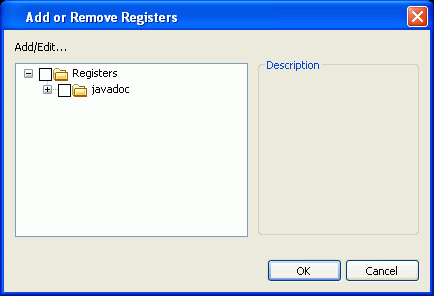
-
Select the registers you want to either add to or remove from
the process flow, then click OK.
-
In the
Property Manager dialog box, click OK.
The variable
is now available as a selection when configuring objects in a process
flow.
x
Using Variables to Affect Process Flow Logic
A variable can be used as content in the data or in
header information, and it can also be used to affect the run‑time
logic behavior of a process flow. The following object can be used
in conjunction with Designer variables to change a flow’s logic:
- Iterator Object
- Decision Test
Object
- Decision Switch
Object
For more detailed information on objects, see Defining Objects in a Process Flow.
x
All but the simplest flows have multiple paths. Each
distinct path through a flow is either an alternate path or parallel
path:
- Parallel
paths execute simultaneously and independently.
- Alternate paths
are sets of paths, only one of which executes.
New paths are created when more than one relationship line exists
for an object. For example, if you deploy a Decision Test object
in your flow, it will return either ‘true’ or ‘false’. The paths
for ‘true’ and ‘false’ are alternate paths since the result of the
logical test can only be true or false, never both. In contrast,
if you create two lines for the ‘true’ state, the two paths created
will execute in parallel.
OnCompletion relationships always execute in parallel to either
the 'true' or 'false' relationships. If you have just one 'true'
and one 'false' relationship, then these will always be alternate
paths.
The Join and Junction objects are related to the concept of parallel
and alternate paths. A Join object acts as a rendezvous point for
parallel paths. Once all the paths coming into the Join have fired,
the Join action is taken. The output of a Join object is a document
that is the result of merging the documents received on each of
its inbound paths.
The Junction object allows alternate paths to rejoin for common
processing.
Scope
Flow- and message‑scoped variables have one shared copy for the
entire flow, therefore, a change made to the variable will be seen
on all parallel paths. Unless various points of the parallel flows
are synchronized, the results written to a global variable may leave
the variable with an unpredictable value.
Flow-scoped variables are deleted at the termination of the process
flow (or sub-flow) in which they are declared. If you need a variable
to be available to the calling flow (parent flow) or to subsequent
components, such as outlets and emitters, choose message as the scope.
Thread-scoped variables are duplicated for each parallel document
path, allowing independent manipulation of each copy. After parallel
paths converge at a Join object, the value of the thread is undefined.
Note: It is your responsibility to keep track of parallel
and alternative flows and the differently scoped variables. The
system will not do this for you.
Pre- and Post-Execution
Often it is necessary to save a value from the processed document
before sending it into an Execution object in order to reuse that
value later in the process flow. Each Execution object has an implicit
facility to assign values to one or more run-time variables prior
to or after execution. From the Pre-Execution of Post-Execution
tabs, you can choose a variable to set, or launch the Property Manager
to create a new variable. Assigning variables through these tabs
provides an alternative to using Set objects in a process flow.
Since both methods perform the same function, you can use the Pre-
and Post‑Execution method rather than numerous Set objects to create
an uncluttered process flow diagram.
The following image is an example of a Pre‑Execution tab in
a Service object Properties dialog box that shows the variable selections
from the Name drop-down list.
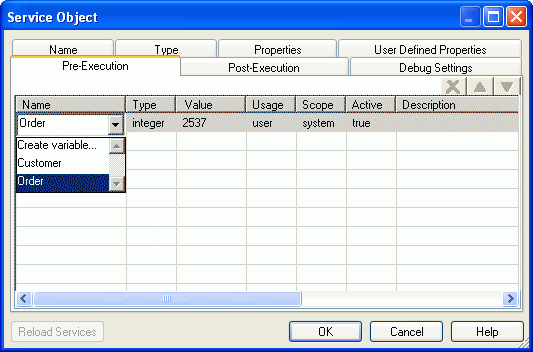
Note: Since design-time variables are substituted within
the Designer at compile time, only run-time variables are permitted
as targets of Pre- and Post-Execution assignment.




